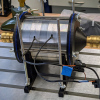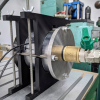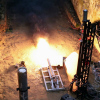Fully electromagnetic valve
Technology description
| The name of the technology: | Fully electromagnetic valve |
|---|---|
| Challenge: | Electromagnetic or solenoid valves are one of the most commonly used control elements for controlling the flow of liquids and gases, both in the manufacturing and processing industries, as well as in the automotive and aerospace industries, and also in the energy, water and gas industries. The main reason for their use is their simple design and operation. However, traditional concepts have limited control options, slow response times and high energy consumption. The proposed technology excels in these aspects, and its commercial use area is thus demanding and safety applications. |
| Description: |
Our fully electromagnetic valve stands out mainly for its low power consumption and high response speed. The valve also makes it possible to achieve a low pressure drop, minimal pressure surges and elimination of malfunctions thanks to precise control. One of the possible uses of the valve is in a rocket engine - research is being conducted in collaboration with the University of Southern California (USC Liquid Propulsion Lab). The valve is original both in the topology of the control actuator and in the design and materials used. The concept went through an intensive testing phase in cooperation with an industrial partner (PEVEKO, spol. s r.o.). The first valve prototype was fully tested up to a pressure of 150 bar, the achieved reaction speed is less than 20 ms and the energy consumption is less than 5 W. The valve can be manufactured both by conventional methods and by using additive technologies (3D printing). In terms of construction, it is fully modular and can therefore be assembled in both bistable and monostable designs. The proof of concept culminated in the validation of a prototype valve in a series of "cold-flow" and "hot-fire" (static ignition) tests of a hybrid rocket engine developed at CTU Space Research in Prague. From the point of view of future implementation, this is a crucial step, during which critical verification of the prototype to the level of technological readiness was achieved. The current development aims to fully verify the technology during the flight phase (launch of the rocket carrier).In addition to CTU Space Research, discussions are underway with the Czech Rocket Society, and cooperation with the USC Liquid Propulsion Laboratory continues concerning testing the prototype for fuel flow control in the Balerion liquid rocket engine. The extreme conditions for which the valve has been designed and the parameters achieved are also promising for other application areas, including the power and transportation industry (turbine control valves, hydrogen management, etc.). |
| Commercial opportunity: |
Based on the technical solutions search, two potential application areas with high added value were identified: (i) hydrogen management systems (generally high-pressure gas and liquid systems) and (ii) rocket propulsion systems. Discussions were then initiated with relevant industrial partners in each area (Chart Ferox, a.s., Frentech Aerospace s.r.o., ATC Space s.r.o., and OHB Czechspace s.r.o.). It is expected that closer cooperation will be established with Chart Ferox, a.s. (hydrogen and LNG management systems) and OHB Czechspace, which, based on initial discussions, has also approached Rocket Factory Augsburg AG, which, like OHB Czechspace, belongs to the OHB Group. However, the commercial use of the proposed concept is broader than demanding environments. Its use as a high-speed solenoid valve for gas pressure control in cooling systems and the developed concept of the control solenoid for direct control of emergency gas valves for pipeline distribution in the gas industry is promising. Using the developed solenoid concept allows complete control (opening/closing) while maintaining passive safety and low power consumption. |
| IP protection status: | Patent application (PV 2023-239) and utility models application (PUV 2023-41077, PUV 2023-41102) |
| Development status: |
Phase 4Corresponds with TRL 7 and TRL 8 The transition from the prototype to the final and fully functional form. At this stage, the prototype is already fully tested, or the technology is certified and ready for mass deployment.
|
| Partnering strategy: | Collaboration licensing |
| More information: | https://cimra.fel.zcu.cz/actuators.html |
| Images: | |
| Categories: | Electrical Engineering |
| Institution: | University of West Bohemia |
| Owner of a technology: | Západočeská univerzita v Plzni |



